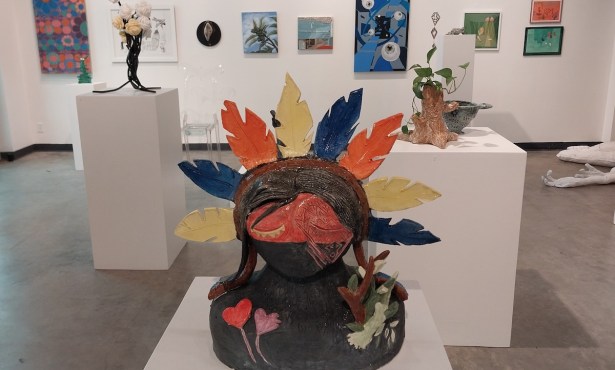Review | ‘A Year with Swollen Appendices’ by Brian Eno
The 25th Anniversary Edition is Just as Engaging as the Original

Several years ago, as I was listening to the ambient music of Brian Eno, which has kept me company through decades of reading, writing, and grading papers, I suddenly recalled that Eno had written a diary that I’d been quite taken with. As I remembered it, the book documented an appealing combination of daily duties and deep thoughts. I should read that again, I thought, but the book wasn’t listed in my local library’s catalog, and on Amazon a used copy was selling for north of $900. For a moment, I was tempted, but good sense prevailed and I resigned myself to the fact that this was another book I would never read again.
How fortunate I felt then when a 25th anniversary edition appeared this February. Diving back into A Year with Swollen Appendices, I readied myself for disappointment. So often, the books we remember as wonderful turn out, later in life, to be something other than what we want them to be. Eno’s diary is, happily, not such a volume.
Because it is grounded in detail, the best way to get a sense of Eno’s project may be to look at a single week of the diary — I’ve chosen Sunday, September the 10th, to Saturday the 16th. Sunday morning before six, Eno rises to go to the airport, though his two young daughters beg him to stay home. Nevertheless, he’s off on a flight from London to Italy, and that night he’s dining at Pavarotti’s restaurant in Modena. Before falling asleep, he has an idea for a new card for his game of creative chance, Oblique Strategies: “What most recently impressed you? How is it similar? What can you learn from it? What could you take from it?” The next morning, he buys nose clippers, then hangs out again with Pavarotti and the members of U2, in preparation for their concert benefiting the “war children” of Bosnia, an idea Eno claims he had after watching a tenth anniversary of Bob Geldof’s Live Aid concert for famine relief in Ethiopia.
There are thoughtful comments on fame and the holocaust, and then it is Tuesday and Eno is buying two new pairs of Italian shoes, receiving medication from Pavarotti’s doctor for a cold, and then performing in the concert itself. Afterwards, the celebrities backstage include Princess Diana, standing shyly by the door and holding a “funny little clutch.” Eno spends Wednesday with his wife in Bologna, shopping and having thoughts like “society is the projection, the summation of our understanding, and … through it, we learn to think in terms of longer nows and bigger heres.” On the 14th, he’s in Amsterdam for a “wild night” of dancing at a party celebrating the launch of a Bosnian-aid album he’s produced. Friday, he’s back home in London, taking his kids to a fish market, where “the fishermen proudly show them live lobsters,” although Eno finds it “difficult to justify meat-eating to kids.” The entry for Saturday is brief, but hardly less eventful: “We went to Fulham, to the pool with the wave machine and slide. I felt chilly — like a cold was coming. Had to get back fast to send tape to U2 (in the south of France) by courier.”
Honestly, I feel tired just recounting Eno’s week — for a 46-year-old man, he’s got a lot of energy. Even his dull days are likely to make some readers jealous; there are so many interesting things going on. On the one hand, it seems astonishing that he is able to get so much done when he shoulders so many responsibilities, self-created and otherwise. And yet Eno seems to thrive on the frenetic energy of always having something else to do. Ultimately, I find his pace of thinking and doing inspirational. If I could only do a tenth of what Eno does in a year, what a year it would be!
The second half of the book contains 150 pages of “swollen appendices.” Set off in pink paper, the appendices discuss everything from ambient and generative music to game playing and lottery ideas (Eno is a big fan of chance as a crucial element in the creative process) to a list of unthinkable futures to a short story about a sperm auction. As with the diary, the random and silly collide with the profound in delightful ways.
A Year is a handsome book, with two ribbons — black and gold — one presumably for the diary, the other for the appendices. However, the 25th anniversary edition is fairly close to the original. In one sense, this is no big deal, as Eno has always been so prescient, especially when it comes to music and technology. Moreover, he does include a (too) brief forward, which features tidbits such as “This era has been called post-truth because language is increasingly intended to be instrumental — that is, intended to bring about an effect — rather than accurate.” Most of the introduction to this edition is taken up with a list of words or phrases that did not exist back in 1995, among them “3D printer,” “Black Lives Matter,” “crowdsource” (a very Enoesque idea), “drone warfare,” “hive mind” (again, this is so Eno), “Minecraft,” “one-click shopping,” “routine mass surveillance,” “telemedicine,” and “universal basic income.” What a book Eno might have written on just those neologisms alone!
Indeed, while I am extremely grateful to see A Year with Swollen Appendices back in the world, I would equally love to see a brand-new diary written for the 21st century. Brian, if you read this, call me. I’ve got some ideas.
This review originally appeared in the California Review of Books.




You must be logged in to post a comment.